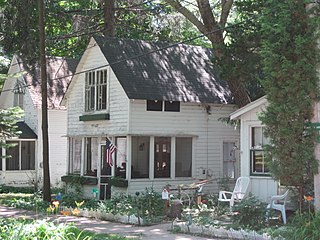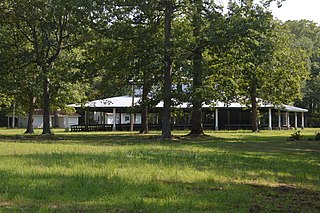
Camp Tosebo, on the south shore of Portage Lake in Onekama Township, Michigan, was established in 1912 by Noble Hill, the headmaster of the Todd Seminary for Boys in Woodstock, Illinois, as one of the first summer camps in the United States. The name of the camp is an acronym derived from the school's name, TOdd SEminary for BOys, and meant to sound like a Native American Indian word. The camp was listed on the National Register of Historic Places in 2000.

The Grand Canyon Lodge is a hotel and cabins complex at Bright Angel Point on the North Rim of the Grand Canyon. It was designed by Gilbert Stanley Underwood, who designed a number of other hotels in national parks for the Utah Parks Company and other concessioners. Built in 1927–28, the Grand Canyon Lodge resort complex consists of the Main Lodge building, 23 deluxe cabins, and 91 standard cabins, some of which were moved to the north rim campground in 1940. All guests are housed in cabins detached from the main lodge, which serves as a dining, concessions and service facility. Constructed of native Kaibab limestone and timber, the complex was designed to harmonize with its rocky and forested setting. The Grand Canyon Lodge complex is notable for its setting and rustic design, as well as its status as the only complete surviving lodge and cabin complex in the national parks.

Wesleyan Grove is a 34-acre (14 ha) National Historic Landmark District in Oak Bluffs, Massachusetts on the island of Martha's Vineyard. Also known as the Martha's Vineyard Campmeeting Association (MVCMA) or the Campgrounds, it was the first summer religious camp established in the United States. It is famous for its approximately 300 colourful cottages in a style now described as Carpenter Gothic.

The Yarmouth Camp Ground Historic District is a historic district encompassing a religious summer camp meeting ground in Yarmouth and Barnstable, Massachusetts. The core of the camp ground was purchased in 1863 by the Sandwich District Camp Meeting Association, a Methodist Episcopal organization, and was operated until 1939. The area contains a well-preserved collection of predominantly residential buildings built during this period; it was listed on the National Register of Historic Places in 1990.

The Old Faithful Historic District in Yellowstone National Park comprises the built-up portion of the Upper Geyser Basin surrounding the Old Faithful Inn and Old Faithful Geyser. It includes the Old Faithful Inn, designed by Robert Reamer and is itself a National Historic Landmark, the upper and lower Hamilton's Stores, the Old Faithful Lodge, designed by Gilbert Stanley Underwood, the Old Faithful Snow Lodge, and a variety of supporting buildings. The Old Faithful Historic District itself lies on the 140-mile Grand Loop Road Historic District.

Indian Field Methodist Campground is a camp meeting site for the Methodist Church in Dorchester County, South Carolina. It is on SC Route S-18-73, off US Route 15, about 5 mi (8 km) north of Saint George. Indian Field was built in 1848 and has been a site for religious gatherings for over 160 years. It is associated with the Indian Field United Methodist Church located on U.S. Highway 15 about 2 miles (3 km) north of the campground and just south of U.S. Highway 178. It was named a historic district of the National Register of Historic Places on March 30, 1973.

Carey's Camp was established in 1888 as a Methodist camp meeting near Millsboro, Sussex County, Delaware. Traditionally occupied for 12 days beginning the last Wednesday of July for prayer and religious instruction, the camp is composed of 47 wood cabins in an oval around a tabernacle. As with many such meeting grounds, the camp is located in a grove of oak trees. The front-gabled cabins almost touch each other. Each cabin has a window in the gable and a porch on the front. The rear of the porch is entirely open to the interior of the house, so that the cabin's occupants could see and be seen from the center. An enclosed kitchen is in the back of the cabin. Sleeping rooms are located upstairs.

The Massanetta Springs Historic District is a retreat in Rockingham County, Virginia, administered by the Presbyterian Synod of the Mid-Atlantic, and chiefly associated with the Massanetta Springs Summer Bible Conference Encampment. The district includes the Hotel (1910), Hudson Auditorium (1922) and Camp Massanetta (1955–56). A Methodist camp existed at the site, originally known as Taylor's Springs, from 1816.

The Bryce Canyon Lodge Historic District surrounds and includes the Bryce Canyon Lodge in Bryce Canyon National Park, as well as the survivors of a large complex of buildings that comprised the core of the park's visitor services area in the 1930s.

The Grand Canyon Inn and Campground, also known as the North Rim Inn, were built by the William W. Wylie and the Utah Parks Company as inexpensive tourist accommodations on the North Rim of the Grand Canyon, in Grand Canyon National Park. Intended to complement the more expensive Grand Canyon Lodge, the cabins and Inn were located near Bright Angel Point, but father back than their more expensive counterparts, near the Grand Canyon North Rim Headquarters. The design of the cabins and the redesign of the Inn building were undertaken by architect Gilbert Stanley Underwood.

Des Plaines Methodist Camp Ground is a historic Methodist church camp at 1250 Campground Road in Des Plaines, Illinois, USA.

Kelly's Camp is a small district of vacation cabins on the west shore of Lake McDonald in Glacier National Park, Montana, USA. Kelly's Camp consists of twelve log buildings along the western shore of the lake. The structures were notable for being one of the most extensive summer cabin enclaves remaining in the park. Early reports following the advance of the Howe Ridge Fire on August 12, 2018 are that nine or ten structures have been destroyed.

Piedmont Camp Meeting Grounds Historic District is a national historic district located at Piedmont, Montgomery County, Virginia. The district encompasses 22 contributing buildings associated with a camp meeting, a seasonal religious campground. The district includes a large, rustic tabernacle (1939), a group of small frame cabins, a dining hall in a former church building, the concrete block Piedmont Pentecostal Holiness Church, and the nave-plan Piedmont Methodist Church, the district's oldest building. The tabernacle is the principal structure in the campground, and is an aisled gable roofed frame structure open on three sides and supported by untrimmed logs. The Piedmont Methodist Church is the church from which the Piedmont Pentecostal Holiness group broke away.

Kirkland Grove Campground is a historic Baptist campground located near Heathsville, Northumberland County, Virginia. It was established in 1892, and was the site of week-long religious services. The main building is the great Tabernacle, built in 1892. It measures 90 feet square and supported by timber columns supporting a standing seam metal hipped roof. The roof has four square tiers rising from the center, each tier growing smaller toward the top. The two other contributing buildings are the Camper's Tent and Preacher's Tent, both built in 1892. The property continues to be used for church meetings, revivals, reunions, and youth camp activities.

Camp Welfare is a historic African-American religious campground located near Monticello, Fairfield County, South Carolina. It was founded after the American Civil War by the African Methodist Episcopal Zion Church. It is a collection of approximately 100 one-story, frame, weatherboarded cabins called tents arranged in a double "U"-shape. The focal point of the camp is the arbor; a rough, gable roofed wooden shelter with wooden benches. Also located at the camp is Zion Church; a frame building with a gable roof surmounted by a belfry built about 1930.
Cattle Creek Campground, also known as Cattle Creek United Methodist Church and Campground, is a historic camp meeting ground that is now a national historic district located near Rowesville, Orangeburg County, South Carolina. The district encompasses 37 contributing buildings and 1 contributing site. It was founded in 1786, although this date has been challenged. The campground burned in 1898 and was rebuilt. Another fire in 2017 destroyed 15 "tents," which were again rebuilt. It includes 36 cabins, called “tents,” arranged in a wide semi-circle. They are located around an open, 56 feet by 81 feet, pavilion structure known as the “stand” or “tabernacle.” Also located on the property is a cemetery. It is one of three remaining Methodist campgrounds in South Carolina.

Balls Creek Campground is a historic Methodist camp meeting and national historic district located near Bandy's Crossroads, Catawba County, North Carolina. The district encompasses 138 contributing buildings and 1 contributing site. They include the Arbor, "tents" dating back to the 1850s, a store called "The Shack", and jail dated to the late-19th / early-20th century.
Tucker's Grove Camp Meeting Ground is a historic African Methodist Episcopal Church camp meeting ground located near Iron Station, Lincoln County, North Carolina. Tucker's Grove Camp Meeting begins the 3rd Saturday of August, and continues until the 4th Sunday, also called 'Big Sunday'. Throughout the week of Camp Meeting, hundreds of camp participants move to the grounds to attend worship services and fellowship with family and friends.

The Advent Camp Meeting Ground Historic District encompasses the early surviving elements of a religious summer camp meeting ground in Hartford, Vermont. Founded in 1887, it is one of a small number of camp meetings surviving from the 19th century in the state, and the only surviving one run by the Advent Christian General Conference. It was listed on the National Register of Historic Places in 2017.

Covenant Beach Bible Camp, now known as Des Moines Beach Park, is a public site in Des Moines, Washington. Established in 1931, it was added to the National Register of Historic Places in 2006.




















